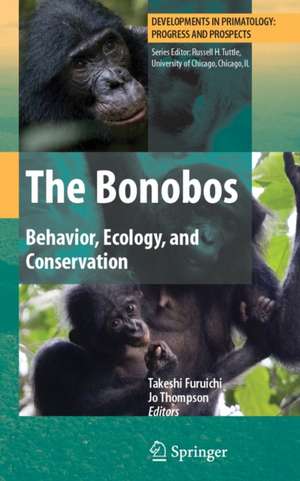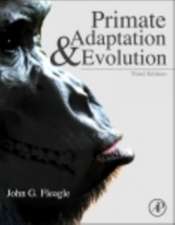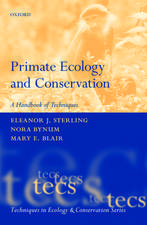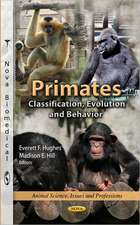The Bonobos: Behavior, Ecology, and Conservation: Developments in Primatology: Progress and Prospects
Editat de Takeshi Furuichi, Jo Thompsonen Limba Engleză Hardback – 3 mar 2008
Part One of The Bonobos: Behavior, Ecology, and Conservation focuses on scientific research. Behavioral studies in captivity propose to answer why bonobos have some unique characteristics such as high social status of females and flexible social relationships. The outcomes present important aspects to be investigated in running field studies. In the wild, analysis of population genetics across the bonobo's distribution range illuminates the species' evolutionary path and contributes to a global management plan. Site specific analysis reveals how genetics are used to re-identify individuals after an extended interruption of long-term research. Ecological studies at three independent sites, two in Salonga National Park, as well as one in the Luo Scientific Reserve, provide valuable information for the comprehension of ecological adaptation of bonobos. With the application of recent methods of mammalian feeding ecology as well as comparative approaches in other great ape species, these studies allow us to draw conclusions on ape ecological adaptation and evolution.
Part Two of The Bonobos: Behavior, Ecology, and Conservation focuses on conservation. In overview, local and global aspects of the factors threatening the wild bonobo population are reviewed. Here the outcomes of large-scale efforts within the functioning ecosystem conservation paradigm focus on three landscapes within the range of the bonobo: the Salonga-Lukenie-Sankuru Landscape, the Maringa-Lopori-Wamba Landscape, and the Lac Télé-Lac Tumba Swamp Forest Landscape, are presented. Papers in thispart include the different aspects of various stakeholders and discuss the unique threats and actions taken to ensure bonobo survival. Pioneering the way, details from the first comprehensive assessment of bonobos in the Salonga National Park reveal a baseline from which to monitor future trends. Concerned about the indigenous' peoples aspects of conservation, an ethnographic study documents cultural, social, and economic practices for the purpose of reviving the local traditional knowledge to exemplify possible applications at the national level. To be inclusive of all aspects of range country concerns, the contributions of Kinshasa's bonobo sanctuary to national conservation efforts are presented. The outcome of these contributions taken together not only illuminate the current status of the bonobo but allow for critically designing the next steps for the continuation of its future.
| Toate formatele și edițiile | Preț | Express |
|---|---|---|
| Paperback (1) | 946.72 lei 43-57 zile | |
| Springer – 29 noi 2010 | 946.72 lei 43-57 zile | |
| Hardback (1) | 802.74 lei 38-44 zile | |
| Springer – 3 mar 2008 | 802.74 lei 38-44 zile |
Din seria Developments in Primatology: Progress and Prospects
- 20%
 Preț: 571.31 lei
Preț: 571.31 lei - 18%
 Preț: 1216.65 lei
Preț: 1216.65 lei - 19%
 Preț: 578.66 lei
Preț: 578.66 lei - 18%
 Preț: 956.69 lei
Preț: 956.69 lei - 18%
 Preț: 948.92 lei
Preț: 948.92 lei - 18%
 Preț: 948.92 lei
Preț: 948.92 lei - 18%
 Preț: 945.79 lei
Preț: 945.79 lei - 18%
 Preț: 962.66 lei
Preț: 962.66 lei - 18%
 Preț: 1664.43 lei
Preț: 1664.43 lei - 18%
 Preț: 1224.54 lei
Preț: 1224.54 lei - 24%
 Preț: 826.25 lei
Preț: 826.25 lei - 18%
 Preț: 1562.94 lei
Preț: 1562.94 lei - 18%
 Preț: 950.21 lei
Preț: 950.21 lei - 18%
 Preț: 943.73 lei
Preț: 943.73 lei - 18%
 Preț: 1549.67 lei
Preț: 1549.67 lei - 18%
 Preț: 1248.20 lei
Preț: 1248.20 lei - 18%
 Preț: 941.38 lei
Preț: 941.38 lei - 24%
 Preț: 800.85 lei
Preț: 800.85 lei - 18%
 Preț: 953.35 lei
Preț: 953.35 lei - 18%
 Preț: 1827.48 lei
Preț: 1827.48 lei - 18%
 Preț: 1214.90 lei
Preț: 1214.90 lei - 18%
 Preț: 957.62 lei
Preț: 957.62 lei - 18%
 Preț: 1231.47 lei
Preț: 1231.47 lei - 18%
 Preț: 1225.48 lei
Preț: 1225.48 lei - 5%
 Preț: 1433.83 lei
Preț: 1433.83 lei - 18%
 Preț: 1231.16 lei
Preț: 1231.16 lei - 18%
 Preț: 1226.90 lei
Preț: 1226.90 lei - 18%
 Preț: 955.25 lei
Preț: 955.25 lei - 18%
 Preț: 956.03 lei
Preț: 956.03 lei - 18%
 Preț: 1218.53 lei
Preț: 1218.53 lei - 18%
 Preț: 950.52 lei
Preț: 950.52 lei -
 Preț: 416.82 lei
Preț: 416.82 lei - 18%
 Preț: 1554.89 lei
Preț: 1554.89 lei
Preț: 802.74 lei
Preț vechi: 1056.23 lei
-24% Nou
Puncte Express: 1204
Preț estimativ în valută:
153.61€ • 160.78$ • 127.85£
153.61€ • 160.78$ • 127.85£
Carte tipărită la comandă
Livrare economică 26 martie-01 aprilie
Preluare comenzi: 021 569.72.76
Specificații
ISBN-13: 9780387747859
ISBN-10: 0387747850
Pagini: 327
Ilustrații: XIII, 327 p.
Dimensiuni: 155 x 235 x 25 mm
Greutate: 0.73 kg
Ediția:2008
Editura: Springer
Colecția Springer
Seria Developments in Primatology: Progress and Prospects
Locul publicării:New York, NY, United States
ISBN-10: 0387747850
Pagini: 327
Ilustrații: XIII, 327 p.
Dimensiuni: 155 x 235 x 25 mm
Greutate: 0.73 kg
Ediția:2008
Editura: Springer
Colecția Springer
Seria Developments in Primatology: Progress and Prospects
Locul publicării:New York, NY, United States
Public țintă
ResearchCuprins
Behavioral Study Section.- The Bonobo’s Adaptive Potential: Social Relations under Captive Conditions.- What Does Agonistic Dominance Imply in Bonobos?.- Social Play in Bonobos: Not Only an Immature Matter.- Gestures and Multimodal Signaling in Bonobos.- Ecological Study Section.- Longitudinal Structure of a Unit-group of Bonobos: Male Philopatry and Possible Fusion of Unit-groups.- Seasonal Changes in Fruit Production and Party Size of Bonobos at Wamba.- Relationships among Fruit Abundance, Ranging Rate, and Party Size and Composition of Bonobos at Wamba.- Bonobo (Pan paniscus) Density Estimation in the SW-Salonga National Park, Democratic Republic of Congo: Common Methodology Revisited.- Ecological Factors Influencing Bonobo Density and Distribution in the Salonga National Park: Applications for Population Assessment.- Range Occupation and Population Estimates of Bonobos in the Salonga National Park: Application to Large-scale Surveys of Bonobos in the Democratic Republic of Congo.- Conservation Study Section.- Traditional Land-use Practices for Bonobo Conservation.- Human Hunting and its Impact on Bonobos in the Salonga National Park, Democratic Republic of Congo.- The Bonobos of the Lake Tumba – Lake Maindombe Hinterland: Threats and Opportunities for Population Conservation.- Changes in the Status of Bonobos, their Habitat, and the Situation of Humans at Wamba in the Luo Scientific Reserve, Democratic Republic of Congo.- The Conservation Value of Lola ya Bonobo Sanctuary.
Recenzii
From the reviews:
"This volume … focuses on the lesser-known species of chimpanzee, Pan paniscus, commonly known as the bonobo or the pygmy chimpanzee. … provides a comprehensive, current perspective on the behavior and ecology of both captive and wild bonobos, as well as the major threats facing their survival. … This work is thus a welcome and important contribution to the primate literature. Summing Up: Highly recommended. Upper-division undergraduates through researchers/faculty." (L. Swedell, Choice, Vol. 46 (2), October, 2008)
"Highlights of this book are the number of Congolese scientists and researchers … recognise that many people interested in the results might not have English as their first (second or even third) language. … The papers are excellent and interesting … . to those working with counting apes elsewhere. … All in all, the book has vital data, good use of analytical techniques and novel discussions of the conservation prospects of the ‘last chimpanzee’, all of which make it well worth owning … ." (P. C. Lee, Primate Eye, August, 2009)
"The Bonobos, edited by Takeshi Furuichi and Jo Thompson, consists of information presented in two symposia held at the 2006 International Primatological Society Congress in Uganda. … The main thrust of the book is the updating of field studies and new data on conservation. … The Bonobos is a welcome update on the state of bonobo research, particularly in the post-war environment of Central Congo." (Randall L. Susman, Primates, Vol. 50, 2009)
"This volume … focuses on the lesser-known species of chimpanzee, Pan paniscus, commonly known as the bonobo or the pygmy chimpanzee. … provides a comprehensive, current perspective on the behavior and ecology of both captive and wild bonobos, as well as the major threats facing their survival. … This work is thus a welcome and important contribution to the primate literature. Summing Up: Highly recommended. Upper-division undergraduates through researchers/faculty." (L. Swedell, Choice, Vol. 46 (2), October, 2008)
"Highlights of this book are the number of Congolese scientists and researchers … recognise that many people interested in the results might not have English as their first (second or even third) language. … The papers are excellent and interesting … . to those working with counting apes elsewhere. … All in all, the book has vital data, good use of analytical techniques and novel discussions of the conservation prospects of the ‘last chimpanzee’, all of which make it well worth owning … ." (P. C. Lee, Primate Eye, August, 2009)
"The Bonobos, edited by Takeshi Furuichi and Jo Thompson, consists of information presented in two symposia held at the 2006 International Primatological Society Congress in Uganda. … The main thrust of the book is the updating of field studies and new data on conservation. … The Bonobos is a welcome update on the state of bonobo research, particularly in the post-war environment of Central Congo." (Randall L. Susman, Primates, Vol. 50, 2009)
Textul de pe ultima copertă
The Bonobos: Behavior, Ecology, and Conservation provides a succinct yet comprehensive review of the current state of research and conservation efforts regarding the bonobos. The bonobos are one of the least known of the great apes although they are one of our closest living relatives, sharing 98.8% of DNA sequences. This text summarizes and analyses scientific research on the bonobos, as well as presents the most up-to-date findings from the field and captive studies. Further, the text presents compelling findings and solid population assessments for estimating wild population density and distribution.
The first section of the book presents research progress in the study of behavior of captive bonobos. These behavioral studies make important strides in our understanding of bonobo social relationships, agonistic dominance, social play, and signaling. The outcomes concerning high social status of females and flexible and complicated social communication may shed light on the study of evolution of both bonobos and humans.
The second section deals with ecological studies that have been carried out since the post- conflict resumption of field research in Democratic Republic of Congo. Methodologies that have been improved over recent years in the study of the other great apes have now been applied to the study of bonobos, which enables comprehensive comparison for understanding hominids'’ adaptation to the African tropical forest. Furthermore, differing and newly -developed census methods have been employed to reveal the current status of bonobos in Africa’s largest forested protected area, the Salonga National Park.
The text's final section centers on the most urgent conservation priorities and reviews local and global aspects of the factors threatening the wild bonobo population. The role of humans in the future of bonobo conservation is examined. Further, the first ever large-scale and small-scale regionalsurveys are presented, as well as how the world’s only sanctuary for orphaned bonobos can respond to offer estimatesthe consequences of population density and distribution through reliable quantitative data. These studies provide compelling results and a solid population assessment.the live animal trade. Encouraging reports detail the presence and abundance of bonobos existing across their historic range. These contributions not only illuminate the current status of the bonobobonobos but allow for critically designing the next steps for the continuation of their future.
About the Editors:
Dr. Takeshi Furuichi is Professor in the Faculty of International Studies of Meiji-Gakuin University, Japan. He has carried out ecological and behavioral studies of bonobos, chimpanzees, and gorillas all across Africa for more than 20 years, in order to reveal the evolutionary process of hominids.
Dr. Jo Thompson is the Director of the Lukuru Wildlife Research Project in the Democratic Republic of Congo. She has maintained her field work for more than 16 years focused on bonobo ecology and conservation in alliance with the local people.
The first section of the book presents research progress in the study of behavior of captive bonobos. These behavioral studies make important strides in our understanding of bonobo social relationships, agonistic dominance, social play, and signaling. The outcomes concerning high social status of females and flexible and complicated social communication may shed light on the study of evolution of both bonobos and humans.
The second section deals with ecological studies that have been carried out since the post- conflict resumption of field research in Democratic Republic of Congo. Methodologies that have been improved over recent years in the study of the other great apes have now been applied to the study of bonobos, which enables comprehensive comparison for understanding hominids'’ adaptation to the African tropical forest. Furthermore, differing and newly -developed census methods have been employed to reveal the current status of bonobos in Africa’s largest forested protected area, the Salonga National Park.
The text's final section centers on the most urgent conservation priorities and reviews local and global aspects of the factors threatening the wild bonobo population. The role of humans in the future of bonobo conservation is examined. Further, the first ever large-scale and small-scale regionalsurveys are presented, as well as how the world’s only sanctuary for orphaned bonobos can respond to offer estimatesthe consequences of population density and distribution through reliable quantitative data. These studies provide compelling results and a solid population assessment.the live animal trade. Encouraging reports detail the presence and abundance of bonobos existing across their historic range. These contributions not only illuminate the current status of the bonobobonobos but allow for critically designing the next steps for the continuation of their future.
About the Editors:
Dr. Takeshi Furuichi is Professor in the Faculty of International Studies of Meiji-Gakuin University, Japan. He has carried out ecological and behavioral studies of bonobos, chimpanzees, and gorillas all across Africa for more than 20 years, in order to reveal the evolutionary process of hominids.
Dr. Jo Thompson is the Director of the Lukuru Wildlife Research Project in the Democratic Republic of Congo. She has maintained her field work for more than 16 years focused on bonobo ecology and conservation in alliance with the local people.
Caracteristici
Consists of two parts which intend to integrate both new scientific insights from captive and wild investigations and the most recent achievements in conservation









